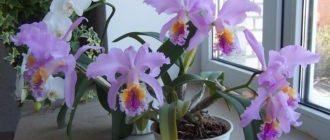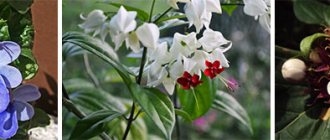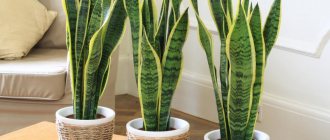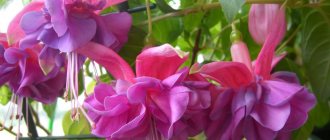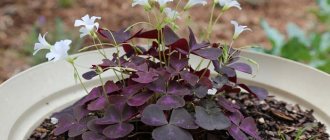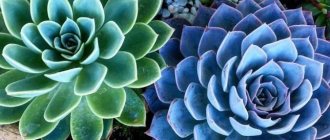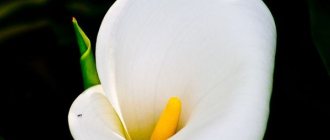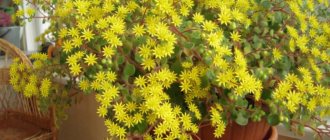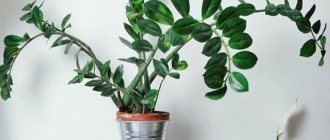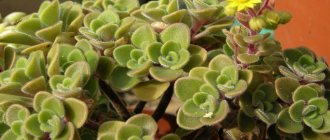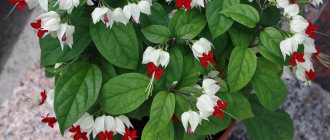Houseplant Clerodendrum - description
Clerodendrum belongs to the verbena family. There are quite a few different varieties of clerodendrum: there are vines, trees, and shrubs. Wild clerodendrums can grow up to four meters, but domestic ones rarely reach even one and a half meters.
In fact, these are perennials, but due to the fact that garden clerodendrum is difficult to winterize and remove from it, they are often grown as annuals: they squeeze out all the juices while the flowering period is in progress, and then, instead of sending them to wintering, they are cut and cut, growing a new plant . Or they just buy new ones.
In addition to traditional names - the flower of fate, innocent love - it is also called the flower of bloody drops for its characteristic bright red tips, or the “cleric flower”, because the flower bending down resembles a praying clergyman, and the shape of the buds resembles fingers gathered with a pinch, as for prayers.
What does clerodendrum look like?
The height that clerodendrum can reach depends on the species, but most often it is two to three meters. It has bright green foliage (its shade ranges from lighter to darker green), the leaves are large, usually oblong, but can be round, heart-shaped or ovate. The buds are small, collected in elegant bouquets, the tips of the petals are bright red. The color of the buds depends on the variety, but most often they are white. It also comes in purple, orange, pink, and red.
A characteristic feature of clerodendrum is its pleasant, delicate aroma. They even say that he can restore his sense of smell.
Where it grows - the birthplace of the plant
It was first discovered in the Canary Islands and is also distributed throughout South America, Asia and Africa.
How and when does clerodendrum bloom?
Blooms from April to October. It is highly valued for its decorativeness, abundance and duration of flowering.
Is clerodendrum poisonous or not?
No, it is absolutely not poisonous, even if your pet eats the leaf, it will not be harmed.
Biological features
The plant resembles a shrub or small tree. Young shoots quickly become stale, turning into part of an elegant trunk. Due to its special flexibility, the plant can be given almost any shape. The height of the perennial shrub varies from 0.7 to 2.5 m.
The shape of the leaves resembles a heart with ribbed or smooth edges. The main color of the leaf plate is light green, rich green. The surface of the massive leaf is rough with pronounced veins.
A distinctive feature is the unique aroma of each type of clerodendrum. At the same time, flowers and leaves have the same smell.
The most attractive part of the bush is the flowering crown. The peculiarity of flowers collected in corymbs is a protruding long stamen. The shape of the flowers varies depending on the variety. The most common flowers are those that resemble a butterfly.
How to care for clerodendrum at home
The easiest way to make any plant bloom at home is with meticulous and attentive care. If we talk about clerodendrum, then you need to take into account the following nuances:
Replanting after purchase
The rules for transplanting after purchase are the same as for a regular transplant. Replanting is necessary because store-bought soil is poor in nutrients, so plants do not live in it for long.
An important point: if you have other plants, then after purchase the clerodendrum is sent to a month-long quarantine, that is, it stands separately from the rest of the plants. This is necessary in order to prevent possible pest infestation. It happens that a flower arrives from a store infected. Then it is easier to cure one specimen than to drive out multiplied insects from your entire collection.
Lighting
Abundant, but scattered. Eastern and southern window sills are suitable, but it is necessary to cover the flower pot with a curtain to prevent sunburn.
Temperature
20-25⁰С. During wintering – not lower than 15⁰С.
Humidity
This is a tropical plant, so it loves moisture. So don't forget to constantly spray the air around it with a spray bottle. This is even more important than watering.
How to water clerodendrum
Traditionally for all plants: warm, settled water at room temperature. The frequency of watering depends on the time of year, but it is easier to overwater clerodendrum than to dry it out, and it is more important to keep the air around it moist, not the soil.
In summer
Two times a week.
in winter
Once a week.
Fertilizer and feeding
Feed during the flowering period (from April to October), once a week, with universal fertilizer for flowering plants. During wintering, feeding is stopped.
Pruning - how to prune clerodendrum correctly
Pruning at home is carried out in early spring. Dry branches, leaves, and dried buds are removed so that they do not take away the strength of the plant.
How to prune clerodendrum to bloom: cut off a third from the top. This stimulates the growth and more luxuriant flowering of the plant, since the root system, as it were, “concentrates” the distribution of vital juices throughout the remaining above-ground part. The ground part has become smaller, but there are no vital juices, which means it will bloom more abundantly.
You also need to pinch the clerodendrum so that it maintains the shape of the bush, because by nature it tends to stretch upward.
What is clerodendrum
The name of the plant is translated from Greek very simply: kleros - “fate”, and dendron - “tree”. This plant became popular in the 19th century, when tropical galleries and winter gardens were in great fashion among aristocrats. Climbing woody vines could be used as living partitions or a beautiful vertical backdrop.
In those days, this plant was more often called volcameria; now the name clerodendrum is more common. Even in ancient Rome, temples of Venus, the goddess of love and beauty, were abundantly decorated with its flowers. Even our ancestors knew a flower that received the name “innocent love” from them.
Clerodendrums have long been used for landscaping rooms, greenhouses, and winter gardens.
The plant belongs to the Verbena family, known for its beautiful flowering. In addition, our hero is famous for its delicate aroma, which intensifies in the evening.
Some species are quite easy to care for and can even be grown in the yard in well-lit areas. For example, the beautiful clerodendrum, which is sometimes called sea, grows even on the southern coasts, not afraid of the burning rays of the sun and salty splashes of water.
If you live in a region with a hot climate, you can easily grow clerodendrum in your yard or garden.
But it would be more correct to say that this is a rather capricious flower that is not so easy to grow correctly in an apartment or house. It is equally demanding on lighting, humidity, watering, temperature; in general, if you want such beauty to live next to you, you will have to follow some rules. Until recently, only a couple of varieties of clerodendrum were available to our flower growers, but now their range is very wide, so the plant is gaining popularity again. Isn't this a reason to study in detail the principle of growing an exotic beauty?
This plant is native to the tropical regions of Asia, South America and Africa. In the wild, at least 400 varieties are known; they are found in the form of trees, shrubs or vines, and can be evergreen or deciduous. In addition to the lush, beautiful flowering, this plant has one more feature: its branches are very flexible, but become woody over time. This will allow you to give the crown any shape that your imagination suggests.
The most common varieties
Among the many varieties of the tree of fate, it is worth highlighting several of the most beloved by our flower growers for their relative ease of care and visual effectiveness. Let's look at them in more detail:
- Mrs. Thomson's clerodendrum (Clerodendrum thomsoniae). It has thin, smooth shoots with a high growth rate. With age, the vine trunk becomes covered with dense woody bark. It is a deciduous plant and most often sheds most of its leaves in the winter. Clusters of inflorescences consist of white, heart-shaped flowers with bright red corollas. The leaves are large, juicy green in color, oblong, pointed in shape, and can reach 12 cm in length. Mrs. Thomson's Volcameria grows very quickly when grown indoors, flowering time is from March to June inclusive.
- Clerodendrum splendens. An evergreen non-deciduous shrub with liana-like shoots. The leaves are almost round in shape, up to 6 centimeters wide, about 8 cm long, with a heart-shaped base, wavy edges and an oblong apex. Corymbose and racemose inflorescences, located in short axils, are collected from red scarlet flowers. With proper care, it will delight you with brilliant blooms all year round.
The color of the petals of Clerodendrum brilliantis is known to artists as scarlet - Philippine (Clerodendrum philippinum). It has wide leaves of a dark green hue, which contrast favorably with dense, up to 20 cm in diameter, inflorescences consisting of pinkish pinkish-white flowers. This variety has a delicate aroma with jasmine-vanilla notes, which becomes especially intense in the evening. This type of Volcameria begins to bloom already in the second year of life.
- Ugandan (Clerodendrum ugandense). An evergreen vine that grows so quickly that a few months after planting it can reach a length of 2 m. The wide, lance-shaped leaves are dark green in color. Few-flowered, loose inflorescences consist of butterfly-like flowers with thread-like blue stamens. The petals on the sides and top are pale blue, the lower petal is purple or lilac-blue.
- Fragrant (Clerodendrum fragrans). An evergreen shrub plant capable of reaching two meters in height.
The leaves are 20 cm long, wide, pubescent, with recessed teeth along the edges, and ovate in shape. The flowers are white with a slight pinkish tint on the outside, collected in apical shields, and are distinguished by a subtle violet-citrus scent. Clerodendrum fragrant blooms almost all year round. Clerodendrum fragrant is characterized by long flowering and long stamens - Clerodendrum Wallich, or Prospero. This variety is also called “Cleopatra’s tears” and “bridal veil” - the plant is an elegant small bush, you can easily place it even on a narrow windowsill. The shoots are tetrahedral, the leaves are lanceolate, 5 to 8 cm long, with wavy edges, dark green. Clerodendrum Wallich is considered the most capricious of all types of this flower: it is difficult to grow indoors due to its demands on air humidity and day length.
- Clerodendrum inerme (Clerodendrum inerme, unarmed or thornless). An evergreen bushy plant characterized by rapid growth. It loves sunlight very much and tolerates growing outdoors - in the yard or garden. It blooms with snow-white flowers with elongated stamens of a violet or lilac hue.
- Clerodendrum Bunge. A fast-growing vine with heart-shaped, dark green leaves that turn purple when exposed to direct sunlight. This species blooms all summer, from June to August inclusive. Wide inflorescences (reaching 16 cm in diameter) from bright crimson buds bloom with pale pink flowers. Thanks to the long stamens, the blossoming inflorescence looks like a salvo of fireworks. If you replant it in the spring, then after 2 months it will begin to bloom.
- Clerodendrum beautiful, or most beautiful (Clerodendrum speciosum). The plant is a shrubby, evergreen, capable of reaching three meters in height. Large, heart-shaped leaves with a shiny surface and covered with hairs are attached to the tetrahedral shoots on long reddish petioles. Flowers of a purple hue are collected in apical panicles. Flowering time is from June to September inclusive.
Growth and flowering of Ugandan clerodendrum - video
Varietal diversity in the photo
Philippine clerodendrum has a jasmine-vanilla aroma. Wallich's clerodendrum can fit even on a narrow windowsill. Ugandan clerodendrum, when properly pruned, can take the form of a tree or bush. Mrs. Thomson's clerodendrum is characterized by rapid growth at home. Fragrant clerodendrum flowers have a tonzi citrus-violet aroma. Clerodendrum brilliant can bloom constantly. throughout the year The pink-purple flowers of Clerodendrum beautiful are striking in their beauty Clerodendrum Inerme is well suited for growing outdoors Clerodendrum Bunge during flowering can be compared to a salvo of fireworks
Seasonal growing conditions - table
| Spring | Summer | Autumn | Winter | |
| Lighting | Well-lit areas of the room with the possibility of shading from direct sunlight. The best place for growing is on east and west windows. | You can move it to a south window or provide additional lighting. | ||
| Temperature | +18…+25 °C | +15…+18 °C | ||
| Air humidity | To ensure an adequate level of humidity, spray the plant with settled or filtered water every evening. |
|
| |
| Watering | Abundant, only with settled water. The top layer of soil in the pot should dry out between waterings. | Moderate, as needed. Do not allow the earthen ball to dry out. |
| |
Among other things, your flower may need support so that the growing vine does not fall to one side, risking falling from the window. This can be a stretched wire or twine, as well as a spacer of any convenient shape.
A ring-shaped support for clerodendrum will help to form an arch from the plant
Planting and care in open ground
Allowed only if you live in the south and your winters are not harsh. Only one species can be grown in open ground - Clerodendrum bunge, known as Clerodendrum garden.
Choosing a place in the garden
Sunny, open, but it is desirable that the sunlight be diffused, because clerodendrum easily gets sunburned.
Planting in open ground
Planted in open ground in spring. It is necessary to make holes for the plant, fill the hole with a layer of drainage, cover it with soil, plant a flower there and fill the hole with soil, leaving no voids.
Watering
Watering itself is not abundant (in summer - once a week, and in winter the plant goes to hibernate), but the bush needs to be sprayed so that there is always a humid atmosphere around.
How to feed clerodendrum after planting in the ground
Complex mineral fertilizing twice a week during the growing season. In the fall, the fertilizing changes to one that contains iron.
Trimming
They are pruned, essentially, in the same way as homemade clerodendrum.
When to prune
In March-April.
How to trim correctly
- Use clean, disinfected instruments;
- Make cuts obliquely, at an angle of 45 degrees - from these it is easier for the flower to grow new shoots;
- You can shape the appearance of clerodendrum that is aesthetically pleasing to you, for example, trim it to the shape of a tree, removing the lower shoots, or vice versa, remove the upper shoots, forming a bush.
- Clerodendrum Bunge loves to grow in breadth. If you don’t like it, bury slate half a meter into the ground around it.
Wintering
When the temperature drops to 12-15⁰C, it is necessary to wrap the flower and spud its roots, otherwise it will freeze. Watering is reduced, but the soil should not be allowed to dry out, and spraying is maintained daily. Water and spray with boiled water, once every two weeks you need to add laundry soap (to the water for irrigation) to prevent pests and fertilizer containing iron (to the water for spraying) to prevent chlorosis.
Where to place a flower pot with a shoot
Clerodendron (photos and care for it are described in the article for informational purposes) tolerates partial shade and bright sun. But, despite its hardiness, flower growers advise placing the pot on the shaded side of the windows ; the east and west sides are perfect.
Clerodendron should be placed on shaded windows
On a northern window, the plant will not receive enough sunlight, and on a southern window, there will be too many direct rays that burn the foliage. In summer, you can take containers outside, but not into open space. On cold nights, it is better to bring pots of flowers into the house.
Reproduction of clerodendrum at home
In order to propagate clerodendrum at home, you will need the following tools:
- Soil mixture for young plants. You can make it yourself, at home: mix one part of peat, turf and sand.
- A large container for seeds and small ones for picking (seven centimeters in diameter, then eleven centimeters - this is for already grown plants, because their root system forms quickly).
- A sharp tool for separating a cutting or leaf - a knife, scissors. The tool needs to be sharp in order to cut a stalk or leaf, and not break it off or file it down, since clean cuts heal faster, unlike “lacerated wounds.” The instrument must be clean, and it must also be wiped with alcohol, since clerodendrum is prone to infection through mechanical damage.
- Crushed activated carbon or ash - you will sprinkle it on the cuts so as not to introduce infection into a fresh wound.
- The material for the greenhouse is polyethylene film or glass.
- Growth stimulator because the cuttings are rooted in water.
Can be propagated by cuttings, leaves or seeds.
Cuttings
It is easiest to carry out cuttings after pruning. The best time for this is spring-summer.
Separate the cutting so that it has a stem and its own pair of leaves. If there is a spine, that is also good, but not necessary. Immerse the cutting in warm, settled water with the addition of a growth stimulant and place it in a warm place illuminated by diffused sunlight. Add water if necessary, because the cutting will actively absorb it.
When roots appear, transplant the cuttings into small containers and cover with a greenhouse. The greenhouse must be ventilated as condensation forms: condensation has formed - remove the greenhouse, wipe the condensation with a cloth and put it back. Make sure that the soil in the container always remains slightly moist.
When new leaves appear on the sprout, transfer it to a larger container (transfer means taking it from the container and putting it in a new one, without clearing the earthen ball from the roots). There is no need to cover with a greenhouse anymore.
After a year, transfer it to a larger container with soil for adult clerodendrums and care for it as if it were an adult plant. But this year it is necessary to pinch the sprout a couple of times (remove stray leaves) so that it grows more luxuriantly.
Leaf
Rooting with leaves is unreliable; there is a 50/50 chance of rooting. However, they root with a leaf in the same way as with a cutting, they just take one leaf instead of a full-fledged cutting.
Seeds
When to sow seeds: late February - early March.
What should be done:
- Take a large container and fill it with soil mixture for seedlings (its composition is indicated above). Sow the seeds. There is no need to bury them, just pour them onto the soil.
- Cover with plastic wrap or glass.
- Place in a well-lit, warm place.
- Ventilate as condensation forms and moisten the soil with a spray bottle.
- The seeds will hatch in one and a half to two months.
- When the seedling has formed two pairs of leaves, you can transplant it into a separate small container (6 cm). When the seedling grows out of the container, it is transplanted into a new, even larger one, and cared for like an adult plant.
Reproduction
The species of clerodendrum in question reproduces exclusively by cuttings. Planting material should have 2-3 internodes with buds.
Procedure:
Cut the cuttings from March to July.- Dip the cut material for planting into an activated carbon solution.
- The next day, change the water to fresh water.
- As soon as the roots form, plant the petioles in separate containers and make a cap from a plastic bottle.
- If you use a container that is too small for planting the cuttings, then after the plant has begun to grow, it should be transplanted by transferring it into a more suitable container.
Detailed video instructions on the nuances of plant propagation:
Transplanting clerodendrum at home
The procedure for transplantation is as follows:
- Disinfect the soil: put it in an oven heated to 100⁰C for half an hour, and then for two to three weeks in a well-ventilated place so that beneficial microorganisms grow in the soil.
- Prepare a new pot and soil (you will read more about them below).
- Pour three centimeters of drainage into the new pot. If necessary, immediately place a support (needed for old plants that cannot support their own weight).
- Carefully remove the plant from the previous pot, clean the soil from the roots, inspect the roots; if there are rotten parts, cut them off with a sharp, disinfected knife and sprinkle the sections with crushed activated carbon or ash. This must be done necessarily, because clerodendrum is susceptible to diseases that are introduced into its body through mechanical damage.
- Place the plant in the middle of the pot for drainage and fill in the remaining soil so that there are no voids left.
- Water the plant immediately.
Ready!
When to replant
Replant in early spring after pruning, then clerodendrum will best cope with the stress of replanting.
Reasons for transplantation:
- The pot became cramped. In young plants this happens annually, because the root system is actively developing, in older plants - once every two to three years. A symptom of a cramped pot is roots protruding above the ground.
- Another reason for replanting is depleted soil. This is indicated by the stopping of the growth of clerodendrum, its yellowing, faded, withered appearance.
- It may also be necessary to replant a plant due to diseases (for example, root rot) or pests that lay eggs in the soil, infecting it.
Priming
Slightly acidic, fertile. You can do it yourself. You will need equal parts of leaf soil, clay soil, peat moss and coarse sand.
You will also need drainage - expanded clay or crushed brick. This is necessary to ensure that the ground does not become waterlogged.
Pot
If you are replanting because the previous pot has become small, then the new one needs to be about a third larger and taller. The material of the pot is not particularly important.
Care
Clerodendrum will be an elegant decoration for any room. However, in order for the plant to look fresh and healthy, you need to familiarize yourself with the requirements for its maintenance.
Lighting
Lack of light negatively affects the plant - it loses leaves. But direct rays should not hit the flower, otherwise there will be burns. Therefore, the best place for growth will be a western or eastern window.
Temperature
To grow successfully, the flower will need normal room temperature - 25 degrees above zero.
This indicator must be adhered to in the summer. In winter, the temperature is significantly reduced to 15-18 degrees.
Clerodendrum is an exotic plant, so with the onset of autumn it should be moved to a cool place. The temperature must be reduced gradually, and when spring comes, it must be increased again to the required level.
Humidity and watering
Abundant watering in the summer heat and moderate soil moisture during the dormant period are what is necessary for the growth and development of clerodendrum. The main thing is that the top layer of the substrate dries out and then you can water the flower again.
The frequency and abundance of watering directly depend on the temperature in which the flower is grown. The higher it is, the more often the procedure should be performed.
Another requirement is high air humidity . Spray the leaves of the plant regularly and take care of high humidity in the room. To do this, you can purchase a humidifier or place containers of water around the perimeter of the room.
Moisture should not get on the flowers, otherwise they will die.
Top dressing
It is necessary to fertilize the plant during active growth and flowering, because
at this time it uses up all its resources. Fertilizers should be alternated , adding them to the soil every 2 weeks. To do this, you need to purchase specialized products in the form of granules, lumps or solution. During the dormant period, the flower will not need fertilizers, so they should be canceled.
Agricola is most often used as a mineral fertilizer, and among humic fertilizers, the drug FlorHumate is popular.
Transfer
Clerodendrum is a fast-growing plant and when the roots become crowded in the pot, it needs to be replanted. Like many indoor flowers, the “tree of fate” is replanted by transshipment, trying not to touch the fragile roots again.
The frequency of transplants depends on age:
- young bushes require annual replanting;
- adult plants are replanted every 2-3 years in the spring.
The procedure is as follows:
- We remove the flower from the pot, having previously moistened the soil (30 minutes before the start of the procedure) along with the soil.
- In the soil prepared in advance, we make a hole for the roots and place the flower in the middle, fill the voids with soil and compact them a little.
- We water the plant, and if necessary, provide support - take a wooden stick or a structure purchased in a store.
Expert opinion
Vera Ivanovna Sh
Since childhood, I have been interested in growing indoor flowers, then I decided to devote my life to landscape design and gardening.
Rooting takes approximately 1 month - during this period it is contraindicated to apply fertilizers to the soil, because The bush has not yet had time to get used to the new environment.
Priming
You need to plant the bush in a specialized substrate for beautifully flowering plants or in your own prepared soil. Making a soil mixture is not difficult. The composition is as follows:
- leaf soil;
- sand;
- clay soil;
- peat.
The components are taken in equal proportions, mixed and disinfected along with the planting container. The bottom of the pot should be covered with a drainage layer of expanded clay, at least three centimeters thick.
Pot
For planting, a ceramic pot is traditionally used - it will provide good stability to the massive shrub. In addition, such a container allows air to pass through well. When replanting, you should not choose a container much larger than the previous one - just increase the volume of the pot by a couple of centimeters in width and depth. Remember that if you choose a wide container, you will not be able to achieve flowering.
Trimming
Clerodendrum grows quite quickly, so it will require regular pruning and pinching. The owner must promptly remove infected areas, dry leaves and inflorescences and prune lignified branches by 1/3. To form a beautiful crown, you should trim the top when the tree reaches a height of 50-70 cm.
To achieve the desired result, pruning is carried out annually.
Clerodendrum diseases with photos and their treatment
The most common indicator that something is wrong with the plant is yellowing of the leaves. Yellowing comes in different forms, and so do the reasons for yellowing. Conventionally, they can be divided into reasons caused by care errors and reasons caused by diseases.
Yellowing that appears due to care errors is like this:
- Yellowing of the leaf edges means the root is damaged. You should remove the plant from the pot, inspect the root system and remove the damaged root.
- Yellow-brown spots of vague shapes are most often sunburn. You just need to move the flower further into the shade or cover it with a curtain, protecting it from direct sunlight. Then the plant will recover on its own.
- Small specks of different colors from yellow to brown are a fungus. The fungus, as a rule, appears in a humid environment, so the problem should be looked for in waterlogging: review the watering system, perhaps replant the plant, simultaneously removing rotten roots.
- The leaf vein has turned yellow - too much fertilizer or, on the contrary, depletion of the soil. In both cases a transplant is required.
Yellowing also occurs due to drafts (from which yellowing occurs very sharply, quickly), too small a pot (the plant is cramped inside, so it cannot develop normally; a symptom of a too small pot is roots protruding from the ground); stagnation of water in the pot due to excessive watering or, conversely, yellowing may be the result of too little watering.
Therefore, first of all, if the leaves of the clerodendrum have turned yellow, you need to reconsider the watering and bring it back to normal.
Yellowing also occurs due to disease.
- Alternaria blight.
Symptoms: black, dry spots on the leaves.
Why does this happen: Alternaria blight often occurs when two factors are combined: dirt around the clerodendrum (for example, you do not remove dead leaves, or there are dry leaves of other plants lying around) and direct sunlight. Also, sometimes Alternaria begins with infection during mechanical damage to the flower.
What to do: remove damaged leaves, treat with fungicides, resume normal watering, remove dirt and dry leaves if there are any around.
- Anthracnose.
Symptoms: round dark spots with a black border that gradually merge together. The stain soon dries, turns white in the center, and then a depression remains in place of the stain. Typically, such spots appear along leaf veins.
Why it appears: ideal conditions for the development of the disease are a combination of heat (22-27 degrees) with high humidity, plus mechanical damage or dirt, through which the disease enters the plant.
What to do: remove damaged parts, treat with fungicides, adjust the conditions so that they are not favorable for anthracosis.
- Septyrosis.
Symptoms: brown oblong spots with a dark rim.
Why it appears: high humidity, dry plant residues around and too much nitrogen fertilizers.
What to do: treat with colloidal sulfur, remove damaged parts of the plant.
- Leaf rust.
Symptoms: literally rust - bronze-colored growths on the leaves. At first these are small pads, but then they increase in size.
Why it appears: waterlogging and plant waste around.
What to do: treat with a preparation containing sulfur.
- Chlorosis.
Symptoms: leaves fade and white spots appear on them.
Causes of appearance: it can be infectious (appears due to pests) and non-infectious (appears for various reasons: lack of feeding or waterlogging of the roots).
What to do: spray or add Ferrovit Ferrylene to the water for irrigation.
- Root rot.
Symptoms: the plant wilts. The danger of this disease is that the rotting roots are not visible, because they are hidden underground. Therefore, it is important to inspect the roots every time you replant; if there are black, rotten parts, remove them.
Why it appears: waterlogging of the root system.
What to do: replant, when replanting, remove damaged roots and sprinkle the cut areas with crushed activated carbon.
- Stem rot.
Symptoms: dark spots on the stem. Appears due to excessive watering.
What to do: remove the damage, treat with a fungicide, reduce watering, then gradually adjust to normal condition (not to waterlogging).
- Powdery mildew or downy mildew.
Symptoms: white coating on the leaves. If the coating is fluffy, it is downy mildew, but the treatment for them is the same.
Why it appears: a combination of plant waste, humidity and cold. Clerodendrum strikes in the open ground in the fall.
What to do: cut off the damaged parts, treat with fungicides, adjust the watering regime.
What pests, diseases and difficulties can you encounter?
When growing Cleodendrum speciosum, the following problems may occur::
- The leaf blades turn yellow and wither. This happens due to too much watering.
- The appearance of brown spots on the foliage is a sign of sunburn.
- The edges of the leaves dry out and the buds fall off. To avoid this problem, you need to increase the air humidity.
- The internodes are long, and the stems have few leaf blades. This indicates a lack of sunlight. If daylight hours are short, you can use phytolamps.
- The plant does not throw out flower stalks. Lack of fertilizer or the grower did not provide the plant with winter rest.
Clerodendrum speciosum is a popular crop that is often used to decorate homes and offices.
The culture has many advantages: long flowering, ease of care and unusual appearance.
Clerodendrum pests
Clerodendrum is a rather fragile and delicate plant, so it is important to periodically inspect it for pests, because the sooner you find insects, the higher the chance that the plant will not be harmed.
So, what pests are typical for clerodendrum:
Whitefly
Why it appears: unlike other pests, the whitefly loves warm and humid climates, not dry ones, and usually appears in such conditions.
Signs of appearance: clerodendrum stops growing, it does not bloom, then yellow spots appear on its leaves, and then a sticky coating. White scales appear on the underside of the leaves - these are larvae. You may also notice the whitefly itself - small white butterflies.
What to do: immediately isolate the clerodendrum from all other plants, since the whitefly is flying, it easily moves to its “neighbors.” Remove all existing insects using a cotton pad soaked in a soap solution, and then treat with an insecticide, for example, Aktara.
Prevention: ventilate the room, preventing the formation of conditions for whiteflies, and do not over-humidify the air around the plant.
Aphid
Signs of appearance: aphids are clearly visible on their own; they are small, round, light green bugs, often located along leaf veins and on the underside of leaves.
Why it appears: usually it is pure luck, there may just be an infected plant somewhere nearby (not even in your house), and the female has flown from there. But often aphids appear where it is warm and where it is dirty and dusty, so do not forget to ventilate the room and tidy up around the flowers, to prevent dirt from getting there.
What to do: wash the plant under a hot shower and treat with insecticides (Aktara, Tanrek, Iskra or similar). Folk remedies - ammonia, dog shampoo, a solution of soap with ash or just ash, but folk remedies are unreliable, it is better to use chemicals.
Spider mite
Signs of appearance: the main, characteristic sign that helps you understand that it is a spider mite in front of you - this is a thin white coating, similar to a cobweb, on the lower parts of the leaves. In addition, the plant does not bloom, the leaves turn yellow, the plant looks lethargic, and its growth stops.
What to do: the system of action is the same as with other pests: wash off the insects, treat with insecticides and replant the plant, since the spider mite lays eggs in the ground.
Why it appears: spider mites love dry, warm climates and dust, so plants standing near heating appliances are at risk, especially in winter.
Mealybug
Signs of appearance: a characteristic lumpy white coating, similar to lumps of cotton wool.
Reasons for appearance: dryness, heat. Mealybugs often attack clerodendrum after transplantation, when the plant has not yet adapted and watering is just being reduced.
What to do: wash the plant thoroughly with soapy water or wipe with alcohol to remove all insects. After this, wash your hands thoroughly and wash your clothes. After this, start treating with insecticides. Most likely, several different types of insecticides will be required; treatment is carried out once every week or two for one and a half to two months.
Shchitovka
Signs of appearance: light small growths, tubercles or scales on the leaves. This is a sign that the plant has been infected recently, because in the later stages, scale insects cover the entire clerodendrum plant, the leaves fall off (and before that they first turn yellow, then darken, dry out and become covered with a sticky coating).
What to do: The first step is to move the plant to a brightly lit place that is well ventilated and where there is no excess moisture in the air. After this, you need to remove all scale insects from the flower and treat it with insecticides. Most likely, you will have to treat with insecticides several times, and different ones, because scale insects have a natural defense mechanism against chemicals - a shield on the back - so they are not susceptible to insecticides. Cross-treatment is possible (two drugs at once).
Prevention: in the spring, when the scale insect larvae hatch, you can preventively spray clerodendrum with a preparation against scale insects. It is also important to regularly inspect all your flowers and quarantine the “new” ones (just purchased) in case they suddenly become infested with insects.
What you need to know about pests in general
- Most often they start by accident. These are insects, you can accidentally bring them on you from the street, they can fly out the window or get caught in the fur of your pet, especially if it is a dog and you are walking it.
- Most often, pests prefer a dry and warm microclimate, so they are especially common in winter, when the air in the apartment is hot and dry from heating devices. Another factor that contributes to the appearance of pests is dust, so it is important to periodically wipe it around the plants.
- When a plant (any plant) becomes infected with pests, the procedure is usually as follows: first, it is necessary to remove all existing insects using a warm shower or a cotton pad moistened with a thick soap solution; secondly, they are treated with insecticide medications; thirdly, as a rule, the plant has to be replanted, because pests usually lay larvae in the ground.
- Treatment with insecticides is often necessary two or three times. Between treatments, take a break of seven to ten days so that the chemicals do not damage the plant itself or leave chemical burns. If after treating with insecticides you still notice insects on the flower, try cross-treatment (with two drugs at the same time) or change the drug, because pests usually easily get used to the effects of chemicals.
- If you find pests on one plant, check the others immediately, because pests usually jump from flower to flower, looking for where else to get nutrients. For the same reason, the infected plant must be isolated from the rest so that the entire collection does not have to be treated at once.
How often should a plant be replanted?
Many gardeners buy an already mature flower, because it is not always possible to grow it from seeds. A newly purchased plant definitely needs to be replanted. Also, the first transplant is performed when the flower grown independently has taken root well and becomes stronger. Then the young plant is replanted once a year.
But, starting from the 6th year of life, the place of residence of the flower is changed regularly once every 3 years. The procedure is performed at any time of the year, but preferably it is the beginning of spring, when active photosynthesis begins.
Popular types of clerodendrum: photos and names
There are many different varieties, there is even a variegated one - with multi-colored petals. You will surely find something to your liking.
Clerodendrum Wallich (Valichi) or bridal veil
Delicate, white flowers, shaped like a lily or orchid, gently flow down on slightly curving stems, truly reminiscent of a bride's veil.
Clerodendrum Schmidt
Similar to the previous variety, but the flowers are smaller and much more abundant, like a snow-white fountain.
Clerodendrum Thompson
One of the most decorative varieties, it is most often grown. The buds are shaped like a palm gathered into slivers, topped with a small red star.
Clerodendrum aculeatum
And here the buds are open, small, soft pink in the middle, looking tender and fragile.
Clerodendrum brilliant or Splendence
An unusual variety: bright red, blooms in a lush stream of small flowers, shaped like tiny tiger lilies.
Clerodendrum Splash of Champagne or Indicum
This variety has flowers on thin, long peduncles, shaped like droplets or bells of lily of the valley.
Clerodendrum Bunge
The variety is suitable for growing outdoors. It has dark green foliage (the leaves are large, rounded), and small pink buds form lush balls.
Clerodendrum Ugandan or Blue Butterfly
The variety is a very beautiful soft blue color, very reminiscent of a more exotic version of violets, forget-me-nots or bluebells.
Clerodendrum Fragrant
This variety's buds are not bell-shaped, nor like lilies, but in the shape of tiny roses, which in turn form a fluffy, fragrant ball.
Clerodendrum Inerme
A rather modest variety compared to the previous one: only five petals per bud, the flowers are small, white, star-shaped, with long pink stamens.
Clerodendrum Calamitosum
A bit reminiscent of "champagne splash", but this variety is more often grown as a small, graceful tree.
Clerodendrum Quadriculare
An unusual variety: the buds grow on thin, long, bright pink peduncles, and the inflorescences themselves are white, which creates a bright, exotic combination.
Clerodendrum Most Beautiful
The variety is notable for its delicate clusters of scarlet-lilac buds, shaped like large drops.
Clerodendrum Prospero
Looks great in a pot; the shape of the clusters of white-yellow inflorescences is a bit reminiscent of bird cherry.
Clerodendrum Speciosum or Lovely
It resembles the “most beautiful” variety, but the color of the flower is slightly different: not scarlet-lilac, but rather a combination of bright red and soft pink.
Clerodendrum philippines
It resembles a “fragrant” variety, but the buds are more regular in shape, and their shade is not white, but rather has a slight white-pink tint.
Clerodendrum Musical Notes
A delicate, graceful variety, delicate and fragile, reminiscent of a more exotic version of lilies of the valley.
Features of the variety and its variety Speciosissium
The variety has a second name - prickly. Shoots can grow up to 3 meters in height. The stems curl and are tetrahedral when cut. The leaves are quite large, wide, and have wavy edges . The petioles grow up to 2-3 cm in length and are red in color.
Flowering is abundant and usually lasts throughout the summer. The inflorescences are apical and have the shape of moths. The core of the flower is purple, and the corollas are dark red.
The plant variety is Speciosissimum.
You can familiarize yourself with other varieties of clerodendrum in separate materials on our portal. Among the brightest and most unusual are Bunge, Thompson, Wallich, Prospero, Philippine, Ugandan, most beautiful, inerme and brilliant.
What the clerodendrum flower brings to the house: signs and superstitions
This white flower with a red center is called differently, and all the names are poetic and beautiful: clerodendrum, which translates as “tree of fate”, volkameria (also spelled “volkameria”, without a soft sign; both names have a right to exist, it’s like John Watson and John Watson from English) or “innocent love”. Such a poetic plant simply could not help but acquire all sorts of signs and superstitions. What are they?
- As you can see, most often clerodendrum is associated with something good, positive - with fate, with love - therefore the signs associated with it are mostly positive. For example, it is believed that it attracts good luck and happiness, good mood, peace and tranquility in family relationships.
- Even if a white flower with red stamens has acquired pests, this does not mean something bad, as with other plants (other plants are considered pests, as if hinting to the owners that something terrible will happen soon).
It’s just that your pet is absorbing negative energy, and therefore weakened and was attacked by pests. This means that you need to pay more attention to your household, take care of them, sort out your quarrels, and, of course, take care of your pet so that it blooms again.
- The flower of fate softens the relationship between spouses, fills them with tenderness and care, and pushes towards reconciliation after a quarrel. If without mysticism, then the girl, of course, will be very pleased if her beloved gives her a beautiful flower with white and red flowers as a sign of reconciliation.
- There is such a sign: if an indoor flower with white and red flowers suddenly turns all its buds towards the door, this means that welcome guests will soon come to you.
- If a flower with red and white flowers suddenly withered unexpectedly, although there was no sign of trouble, this is sometimes associated with some kind of magical intervention: perhaps someone cast a spell on the owner of the plant, and the clerodendrum took all the negative energy for itself, could not cope and died. However, much more often this is still due to care errors.
- But if the clerodendrum plant is actively blooming, exudes a fragrant aroma and makes you happy with your health, it means that everything is calm and prosperous in the house, relationships are harmonious, everything is in order.
- Unexpected flowering in the middle of winter symbolizes the resumption of a relationship with a person with whom you broke up a long time ago, most often with an ex-partner, less often with a friend.
- And in general, the flowering of clerodendrum always means something positive: for example, good luck, the emergence of new feelings, the revival of love in a couple where passions have long subsided.
- If a white indoor flower with a red center appeared to you in a dream, then this is also a good sign. Most often, this portends new love, strong, sincere feelings. For women, this symbolizes a new boyfriend, and for men, it symbolizes a meeting with a woman whom he would like to call his wife.
- But if in a dream there was not only a clerodendrum flower, but also other people, it means that you will soon attend the wedding of these people or celebrate their birthday.
- They say that clerodendrum loves classical music and affectionate treatment. Scientists, of course, doubt that plants are capable of perceiving art or emotion, but why not say something nice about a flower that delights you with beauty every day?
Why does it bloom?
It is considered a good sign that Thompson clerodendrum blooms in winter , which is unusual for this process. Numerous volkameria buds mean good luck in love and business. If a plant suddenly blooms in the middle of winter, get ready for pleasant surprises in the love sphere: this could be a new relationship, reconciliation with a partner, as well as a revival of feelings in a long, fading romance.
In aesthetic terms, the flowering of Thompson clerodendrum is of particular value. The flowering of this vine occurs in several stages:
- Snow-white sepals appear first;
- then scarlet petals;
- then the stamens open;
- and finally the flowers acquire a light lilac color.
If volkameria blooms profusely and develops, then everyone in the family is healthy and happy, but if the plant withers, there is discord in the family.
Clerodendrum in the interior: photo
Transplantation without the risk of injury. Step-by-step instruction
An adult plant is transplanted into a pot 5-6 cm larger than the previous one, and a young plant, due to annual transplants, 2-3 cm larger. It is advisable to carry out the procedure in early spring during the active process of photosynthesis. Transplantation is carried out by transshipment.
The algorithm is as follows:
- A drainage layer and soil are poured into the prepared pot.
- A depression is made according to the size of the root system of the flower.
- The plant is carefully dug out of the ground along with a lump of earth, trying not to disturb the root system.
- Rotten and damaged roots are removed.
- The flower sits in the recess and is compacted well. If necessary, add more substrate.
- The plant is watered abundantly and placed in a semi-shaded place, with an air temperature of at least 20 degrees.
Fertilizers for plants
Over time, the soil loses its nutritional value, so any indoor plant requires feeding. Fertilizers can be different; they can be purchased in specialized stores or prepared independently. Nutrient mixtures and solutions are added when watering a flower or poured onto the soil under the root.
Mineral
Mineral fertilizers are usually purchased in stores. They contain a complex of minerals necessary for the plant. Manufacturers indicate exactly what substances and what types of plants they are intended for.
Complex mineral fertilizer
For clerodendron, you can take fertilizers with a complex of substances (nitrogen, potassium, phosphorus, magnesium, fluorine). Since the flower blooms actively and almost continuously, it needs feeding once a month. This will ensure abundant and lush flowering throughout the year.
Organic
As organic matter, flower growers use:
- manure;
- chicken droppings;
- compost;
- seaweed;
- bone flour;
- sawdust;
- eggshell.
All these materials contain certain nutrients necessary for the plant. Compost, chicken manure or eggshells are perfect for clerodendron. Such fertilizing will enhance the growth of the main stem, add brightness to flowering and rich foliage.
Rules for pruning plants
Without pruning, clerodendron grows rapidly upward, reaching gigantic sizes. The procedure is performed in the spring. It is recommended to shorten 1/3 of the shoots. The tops of the longest trunks are cut off, forming the required shape.
Pruning stimulates the plant to flower, and cuttings can be used for further planting
Pruning rejuvenates the flower, improves its appearance and stimulates flowering. In addition to cuttings that disturb the appearance, dried and diseased shoots are also removed.
To form a strong trunk, it is necessary to cut off the side shoots as they grow, forcing the stem to grow to the desired height. When the result is obtained, young shoots are pinched, which stimulates branching. The lower shoots located on the root collar are removed completely.
